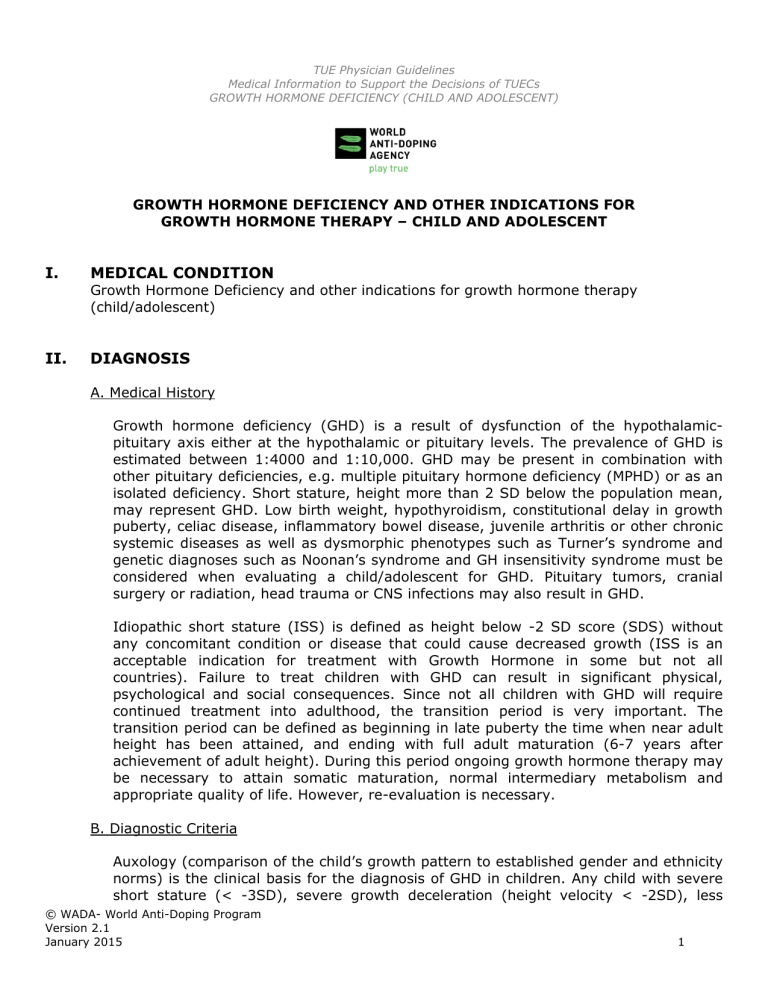Growth Hormone Deficiency

TUE Physician Guidelines
Medical Information to Support the Decisions of TUECs
GROWTH HORMONE DEFICIENCY (CHILD AND ADOLESCENT)
GROWTH HORMONE DEFICIENCY AND OTHER INDICATIONS FOR
GROWTH HORMONE THERAPY – CHILD AND ADOLESCENT
I. MEDICAL
Growth Hormone Deficiency and other indications for growth hormone therapy
(child/adolescent)
II. DIAGNOSIS
A. Medical History
Growth hormone deficiency (GHD) is a result of dysfunction of the hypothalamicpituitary axis either at the hypothalamic or pituitary levels. The prevalence of GHD is estimated between 1:4000 and 1:10,000. GHD may be present in combination with other pituitary deficiencies, e.g. multiple pituitary hormone deficiency (MPHD) or as an isolated deficiency. Short stature, height more than 2 SD below the population mean, may represent GHD. Low birth weight, hypothyroidism, constitutional delay in growth puberty, celiac disease, inflammatory bowel disease, juvenile arthritis or other chronic systemic diseases as well as dysmorphic phenotypes such as Turner’s syndrome and genetic diagnoses such as Noonan’s syndrome and GH insensitivity syndrome must be considered when evaluating a child/adolescent for GHD. Pituitary tumors, cranial surgery or radiation, head trauma or CNS infections may also result in GHD.
Idiopathic short stature (ISS) is defined as height below -2 SD score (SDS) without any concomitant condition or disease that could cause decreased growth (ISS is an acceptable indication for treatment with Growth Hormone in some but not all countries). Failure to treat children with GHD can result in significant physical, psychological and social consequences. Since not all children with GHD will require continued treatment into adulthood, the transition period is very important. The transition period can be defined as beginning in late puberty the time when near adult height has been attained, and ending with full adult maturation (6-7 years after achievement of adult height). During this period ongoing growth hormone therapy may be necessary to attain somatic maturation, normal intermediary metabolism and appropriate quality of life. However, re-evaluation is necessary.
B. Diagnostic Criteria
Auxology (comparison of the child’s growth pattern to established gender and ethnicity norms) is the clinical basis for the diagnosis of GHD in children. Any child with severe short stature (< -3SD), severe growth deceleration (height velocity < -2SD), less
© WADA- World Anti-Doping Program
Version 2.1
1
TUE Physician Guidelines
Medical Information to Support the Decisions of TUECs
GROWTH HORMONE DEFICIENCY (CHILD AND ADOLESCENT) severe short stature (<-2SD) and growth deceleration (<-1SD), history of brain tumor,
CNS infection, cranial irradiation, other organic pituitary abnormality or radiologic evidence of pituitary abnormality is a candidate for GHD evaluation.
The diagnosis of GHD is established by evaluation of the GH-IGF-1-IGFBP axis and confirmed through biochemical testing. Evaluation for GHD should be performed with evidence of hypothalamic-pituitary disease, after cranial irradiation, for individuals who have other pituitary hormone deficiencies, for individuals who have been treated for
GHD as a child.
Evaluation of child with suspected GHD should include: a.
History and physical exam specifically investigating presence of chronic diseases or dysmorphic genetic disorders; b.
Measurement of height with comparison to gender and ethnic norms; c.
Calculation of height velocity; d.
Evaluation for genetic disorders e.g. PROP-1, POU1F1 (Pit-1), LHX-3, LHX-4 when indicated. e.
Radiological evaluation a.
Bone age estimation from x-ray of left wrist and hand; b.
MRI of hypothalamic-pituitary region f.
Measurement of growth factor concentrations a.
Insulin-like growth factor-1 (IGF-1) b.
Insulin-like growth factor binding protein (IGFBP-3) c.
Growth hormone stimulation tests i.
Insulin Tolerance Test (contraindicated in young children) ii.
GHRH+Arginine Test - with BMI adjustments for obesity iii.
Glucagon Stimulation Test
C. Transition period (as defined in Section II A.)
1.
Re-evaluation for the adolescent/young adult who is transitioning having been treated for childhood GHD is mandatory because some forms of childhood GHD may recover. For emerging adults who were diagnosed with GHD as children/adolescents an IGF-1 level should be measured after 2-4 weeks off rhGH therapy. However, in some conditions a GH stimulation test is not required because GHD is almost certain on clinical or genetic grounds. This applies to patients with: a.
More than three additional pituitary hormone deficits and a low IGF-I level
(strong evidence for hypopituitarism) b.
Transcription factor mutation known to result in pituitary maldevelopment and hypopituitarism (e.g. POUIF1 (Pit-1), PROP-1, LHX-3, LHX-4) c.
Mutations in genes known to result in isolated GHD (e.g.GH-1 or GHRH-R)
2.
This re-evaluation should be performed when linear growth has ceased and includes: a.
Height, weight, BMI, anthropometric measurements b.
Serum IGF-1 levels
© WADA- World Anti-Doping Program
Version 2.1
January 2015 2
TUE Physician Guidelines
Medical Information to Support the Decisions of TUECs
GROWTH HORMONE DEFICIENCY (CHILD AND ADOLESCENT) c.
GH Stimulation tests (for threshold levels of these test refer to Ho et al.
Consensus Guidelines… or Cook et al, AACE Medical Guidelines.. both are listed below) i.
Insulin Tolerance Test ii.
GHRH+Arginine Test - with BMI adjustments for obesity iii.
Glucagon Stimulation Test
D. Relevant Medical Information a.
GH and IGF-1 results must be expressed in mass units. b.
Low IGF-1 concentration below normal range is insufficient evidence for
GHD. Stimulation testing must be performed if there is no other evidence
of hypothalamic-pituitary dysfunction. c.
Therapeutic use exemption (TUE) for the treatment of GHD should be
granted for only those who have conclusive evidence of Growth Hormone
Deficiency (GHD). d.
Subjects should be investigated for other anterior pituitary deficits and
these should be replaced and monitored. e.
Cardiovascular risk markers should be assessed and managed
appropriately. f.
Bone density may be affected negatively in those with GHD and should be
monitored. g.
As part of therapy, quality of life (QoL) may be monitored by use of GHD
specific questionnaires, e.g. QoL-AGHDA.
III. TREATMENT
1.
Name of prohibited substance – recombinant growth hormone, e.g. Genotropin,
Humatrope, Norditropin, Nutropin, Omnitrope, Saizen, Valtropin, TevTropin
2.
Route a.
Subcutaneous injections
3.
Starting Dose a.
0.025-0.050 mg/kg/day
4.
Monitoring treatment a.
Adjust dose dependent upon growth response (change in height SDs or change in height velocity), adverse effects and IGF-1 levels maintained at 0 – +1 SD unless previous history of malignancy in which case suggested IGF-1 levels < 0
SD.
5.
Duration a.
Childhood onset GHD requires re-evaluation within the transition period.
IV. OTHER NON-PROHIBITED ALTERNATIVE TREATMENTS
No alternative for human growth hormone substitution.
© WADA- World Anti-Doping Program
Version 2.1
January 2015 3
TUE Physician Guidelines
Medical Information to Support the Decisions of TUECs
GROWTH HORMONE DEFICIENCY (CHILD AND ADOLESCENT)
V. CONSEQUENCES TO HEALTH IF TREATMENT IS WITHHELD
The following consequences to health for individuals with untreated GHD include:
1.
Persistent growth failure
2.
Decreased quality of life
3.
Decreased bone mineral density
4.
Increased fat mass
5.
Increased cardiovascular risk with negative effects on cardiovascular risk factors: a.
inflammation b.
dyslipidemia c.
insulin resistance
MONITORING
Treatment should be monitored using the following:
1.
BMI
2.
IGF-1 levels
3.
Blood glucose and Hemoglobin A1c
VII. TUE VALIDITY AND RECOMMENDED REVIEW PROCESS
1.
Eight years if genetic, congenital or hypothalamic-pituitary structural abnormality.
2.
Four years if due to brain trauma, irradiation or idiopathic.
The results of regular monitoring should be submitted annually for review.
VIII. ANY APPROPRIATE PRECAUTIONARY MATTERS
Due to the significant risk for abuse of growth hormone for performance enhancement, these requirements must be strictly followed. The diagnosis should be confirmed by an endocrinologist. Also, the reviews of these TUE should be reviewed by an endocrinologist.
Most patients with GHD self-administer GH. Although self-administration may seemingly present difficulty with monitoring, a log book of growth hormone prescriptions and administration should be maintained by the athlete. The administration log book may be subject to review at any time including for the annual review.
Quantities of growth hormone delivered to the athlete must be strictly controlled and limited by prescription.
© WADA- World Anti-Doping Program
Version 2.1
January 2015 4
TUE Physician Guidelines
Medical Information to Support the Decisions of TUECs
GROWTH HORMONE DEFICIENCY (CHILD AND ADOLESCENT)
REFERENCES
GH Research Society. Consensus Guidelines for the Diagnosis and Treatment of Growth
Hormone (GH) Deficiency in Childhood and Adolescence: Summary Statement of GH
Research Society, Journal of Clinical Endocrinology and Metabolism, 85 (11): 3990-3993.
2000.
Cohen, P et al. Consensus Statement on the Diagnosis and Treatment of Children with
Idiopathic Short Stature: A Summary of the Growth Hormone Research Society, the
Lawson Wilkins Pediatric Endocrine Society and the European Society for Paediatric
Endocrinology Workshop. J Clin Enocrinol Metab 93(11):4210-4217, 2008
Cook, DM et al. American Association of Clinical Endocrinologists Medical Guidelines for Clinical
Practice for Growth Hormone Use in Growth Hormone Deficient Adults and Transition
Patients – 2009 Update: Executive Summary of Recommendations. Endocrine Practice,
15(6): 580-586. 2006
Cook, DM and Rose, SR. A Review of Guidelines for Use of Growth Hormone in Pediatric and
Transition Patients, Pituitary, 15: 301-310. 2012
Ho, KKY et al. Consensus Guidelines for the Diagnosis and Treatment of Adults with GH
Deficiency II: a statement of the GH Research Society in association with the European
Society for Pediatric Endocrinology, Lawson Wilkins Society, European Society of
Endocrinology, Japan Endocrine Society and Endocrine Society of Australia. European
Journal of Endocrinology, 157: 695-700. 2007.
Inzaghi, E and Cianfarani, S. The Challenge of Growth Hormone Deficiency Diagnosis and
Treatment during the Transition from Puberty into Adulthood, Frontiers in Endocrinology,
4 (34): 1-8. 2013.
Mauras, N. GH use in the transition of adolescence to adulthood, Endocrine Development,
18:109-25. 2010.
Richmond EJ and Rogol AD. Growth Hormone Deficiency in Children. Pituitary 11: 115-120.
2008.
Richmond EJ and Rogol AD, Current Indications for Growth Hormone Therapy for Children and
Adolescents. Current Indications for Growth Hormone Therapy, Hindmarsh PC (ed) Endocr
Dev, Basel Karger, Chapter 7, 18:92-108. 2010
Silvers, JB et al. A National Study of Physician Recommendations to Initiate and Discontinue
Growth Hormone for Short Stature. Pediatrics 126:468-476, September,2010
Stanley, T. Diagnosis of Growth Hormone Deficiency in Childhood. Curr Opin Endocrinol
Diabetes and Obesity, 19 (1):47-52. February, 2012.
© WADA- World Anti-Doping Program
Version 2.1
January 2015 5


